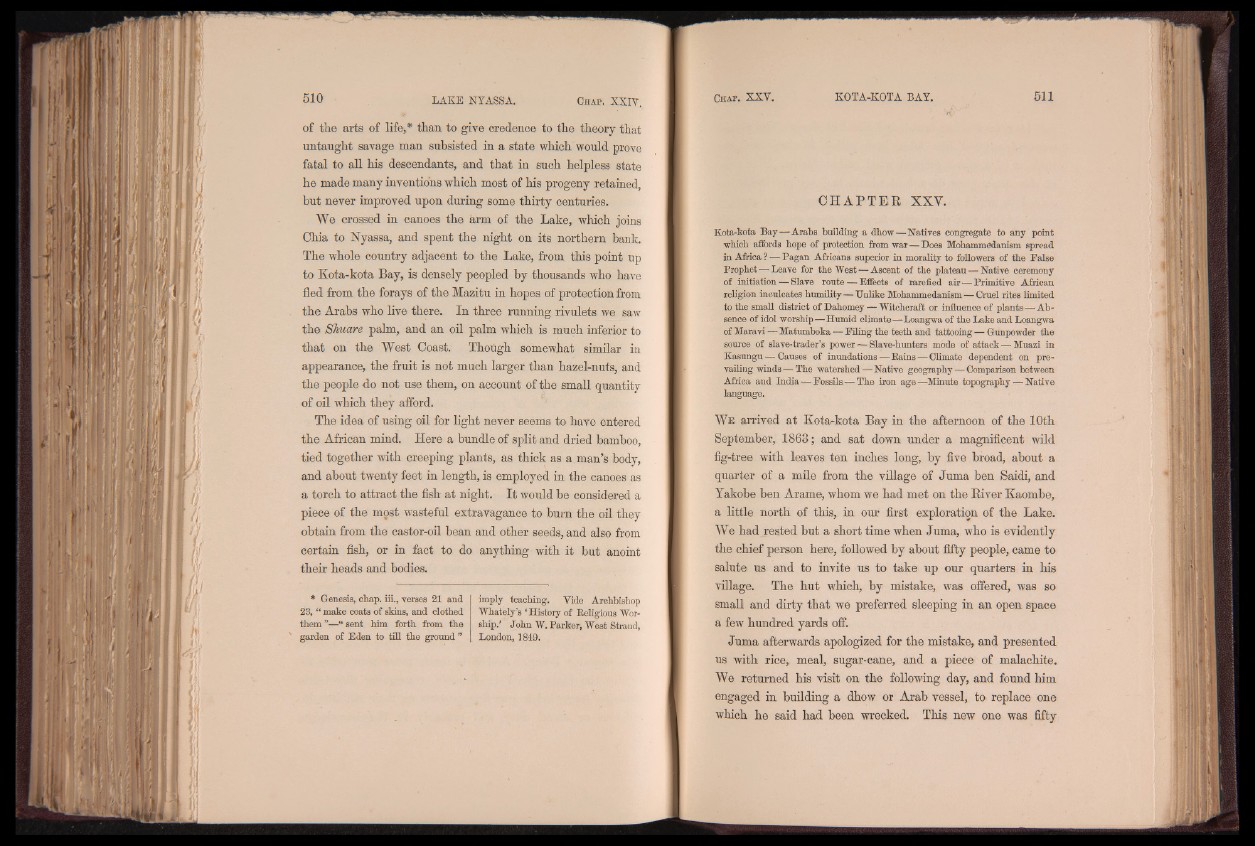
of the arts of life,* than to give credence to the theory that
untaught savage man subsisted in a state which would prove
fatal to all his descendants, and that in such helpless state
he made many inventions which most of his progeny retained,
but never improved upon during some thirty centuries.
We crossed in canoes the arm of the Lake, which joins
Chia to Nyassa, and spent the night on its northern bank.
The whole country adjacent to the Lake, from this point up
to Kota-kota Bay, is densely peopled by thousands who have
fled from the forays of the Mazitu in hopes of protection from
the Arabs who live there. In three running rivulets we saw
the Shuare palm, and an oil palm which is much inferior to
that on the West Coast. Though somewhat similar in
appearance, the fruit is not much larger than hazel-nuts, and
the people -do not use them, on account of the small quantity
of oil which they afford.
The idea of using oil for light never seems to have entered
the African mind. Here a bundle of split and dried bamboo,
tied together with creeping plants, as. thick as a man’s body,
and about twenty feet in length, is employed in the canoes as
a torch to attract the fish at night. I t would be considered a
piece of the most wasteful extravagance to burn the oil they
obtain from the castor-oil bean and other seeds, and also from
certain fish, or in fact to do anything with it but anoint
their heads and bodies.
* Genesis, chap. in., verses 21 and
23, “ make coats of skins, and clothed
them”—“ sent him forth from the
garden of Eden to till the ground ”
imply teaching. Vide Archbishop
'Whatel'y’s ‘ History of Keligious Worship.’
John W. Parker, West Strand,
London, 1849.
C H A P T E R XXY.
Kota-kota Bay—Arabs building a dbow—Natives congregate to any point
which affords hope of protection from war — Does Mohammedanism spread
in Africa ? — Pagan Africans superior in morality to followers of the False
Prophet—Leave for the West—Ascent of the plateau — Native ceremony
of initiation — Slave route — Effects of rarefied air — Primitive African
religion inculcates humility — Unlike Mohammedanism—Cruel rites limited
to the small district of Dahomey — Witchcraft or influence of plants—Absence
of idol worship—Humid climate—Loangwa of the Lake and Loangwa
of Maravi — Matumboka — Filing the teeth and tattooing — Gunpowder the
source of slave-trader’s power — Slave-hunters mode of attack—Muazi in
Kasungu — Causes of inundations — Rains—Climate dependent on prevailing
winds— The watershed -^Native geography — Comparison between
Africa and India—Fossils — The iron age—Minute topography — Native
language.
W e arrived at Kota-kota Bay in the afternoon of the 10th
September, 1863; and sat down under a magnificent wild
fig-tree with leaves ten inches long, by five broadj about a
quarter of a mile from the village of Juma ben Saidi, and
Yakobe ben Arame, whom we had met on the River Kaombe,
a little north of this, in our first exploration of the Lake.
We had rested but a short time when Juma, who is evidently
the chief person here, followed by about fifty people, came to
salute us and to invite us to take up our quarters in his
village. The hut which, by mistake, was offered, was so
small and dirty that we preferred sleeping in an open space
a few hundred yards off.
Juma afterwards apologized for the mistake, and presented
us with rice, meal, sugar-cane, and a piece of malachite.
We returned his visit on the following day, and found him
engaged in building a dhow or Arab vessel, to replace one
which he said had been wrecked. This new one was fifty